Finishes
Galvanizing
Galvanized steel is a method of corrosion protection and is not to be considered as a controllable "architectural finish". The nature of the coating will vary as a function of the zinc bath, underlying steel, heat of the process and exposure to weather. Consistency from piece to piece is absolutely not possible, so if you expect a very uniform look, you will not get it.
Galvanized finishes are increasingly seen in AESS applications. It is important to remember that in the view of the steel industry, galvanizing was not intended as a "finish", but as a preventative measure against corrosion. The speckled grey finish is guaranteed to vary from batch to batch, even within the same manufacturer. It will also vary as a function of the application technique and the style, size and shape of the member to which it is being applied.
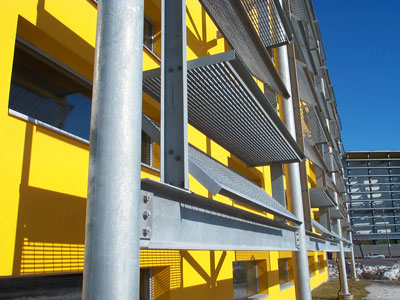 |
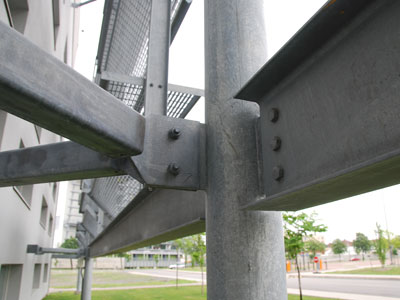 |
Galvanizing has been chosen as both the finish and corrosion protection method at this sunscreen at the Cirque de Soleil Headquarters in Montreal. |
Even close to 6 years later, the galvanized finish is standing up to weather, with no signs of corrosion at all. You can see that the detailing of the connection suits the rugged finish. |
Achieving a good quality coating requires that the surface be free of grease, dirt and scale of the iron or steel before galvanizing. When the clean steel component is dipped into the molten zinc (+/- 450°C) a series of zinc-iron alloy layers are formed by a metallurgical reaction between the iron and zinc. When the reaction between iron and zinc is complete there is no demarcation between steel and zinc but a gradual transition through the series of alloy layers which provide the metallurgical bond. This helps to make the galvanized finish highly durable as it cannot easily be chipped away. The thickness of the coating is determined by the thickness of the steel. The galvanized coating can be made thicker by roughening the steel, thereby creating more surface area for the metallurgical reaction to take place.
Galvanized coatings protect steel in three ways:
1. The zinc weathers at a very slow rate giving a long and predictable life.
2. The coating corrodes preferentially to provide sacrificial protection to small areas of steel exposed through drilling, cutting or accidental damage.
3. If the damaged area is larger, sacrificial protection prevents sideways creep which can undermine coatings.
No post-treatment of galvanized articles is necessary. Paint or a powder coating may be applied for enhanced aesthetics or for additional protection where the environment is extremely aggressive.
The resistance of galvanizing to atmospheric corrosion depends on a protective film which forms on the surface of the zinc. When the steel is lifted from the galvanizing bath, the zinc has a clean bright, shiny surface. With time this changes to a dull grey patina as the surface reacts with oxygen, water and carbon dioxide in the atmosphere. This forms a tough, stable, protective layer that is tightly bonded to the zinc. Contaminants in the atmosphere will affect this protective film. The presence of SO2 greatly affects the atmospheric corrosion of zinc.
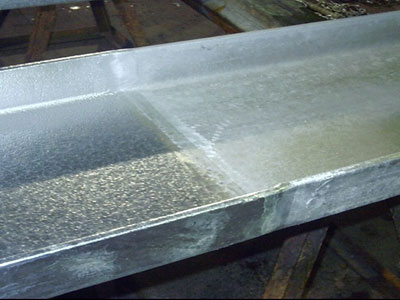 |
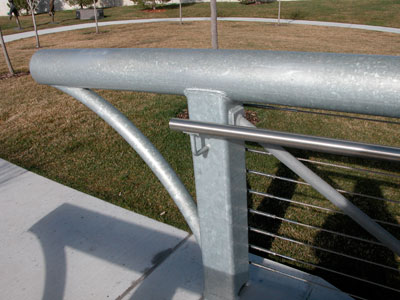 |
One of the technical realities of using galvanizing as a "finish" lies in the inconsistency of the product. The difference in this photo is due to finishing temperatures. If galvanizing is used as a final coating on an AESS project differentials in finish must be both understood and detailed into the project. |
Seal welds have been used to connect the various components of this exterior galvanized steel feature railing. There is a large opening at the base of the square HSS post to allow any water that may enter the railing an opportunity to drain. |
Complex shapes and most hollow items can be galvanized, inside and out, in one operation. Where AESS is being installed in an exterior environment it is critically important that all surfaces be coated. For HSS members this will mean coating the interior of the shape as well - increasing the surface area for coating and potentially increasing the cost. Good member design requires:
• means for the access and drainage of molten zinc
• means for escape of gases from internal compartments (venting)
It is important to bear in mind that the steelwork is immersed into and withdrawn from a bath of molten zinc at about 450°C. This temperature can cause distortion in thinner steels. If the use of the galvanized coating is known early on during the design process, it may be decided to increase the thickness of the steel to prevent distortion.
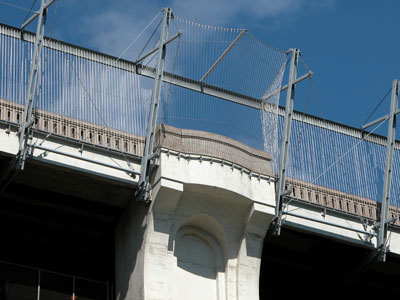 |
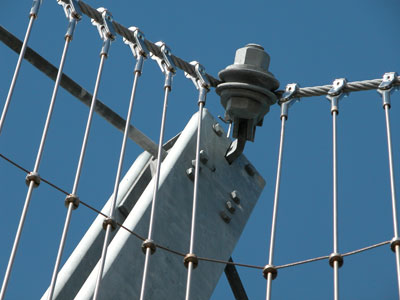 |
Galvanizing is an obvious choice for a combined finish and corrosion method for exterior installations where maintenance will present a problem. These safety barriers on the Prince Edward Viaduct in Toronto are high above the valley. Maintenance is difficult and durability is important. |
Many kinds of steel products can be hot dip galvanized. The Safety Barriers use a wide variety of HSS shapes, wires, rods, bolts and other miscellaneous fittings. It important to ensure that all surfaces are galvanized, that no plain steel products are used, in order to prevent rusting. |
Any features which aid the access and drainage of molten zinc will improve the quality of the coating and reduce costs. With certain fabrications, holes which are present for other purposes may fulfil the requirements for venting and draining; in other cases it may be necessary to provide extra holes for this purpose. For complete protection, molten zinc must be able to flow freely to all surfaces of a fabrication. With hollow sections or where there are internal compartments, the galvanizing of the internal surfaces eliminates any danger of hidden corrosion during service.
From a design perspective it will be important to understand the physical limitations of the galvanizer's facility. To be specific, what is the size of the bath? It is not usual to dip pieces that are 20 metres in length, but this limit must be verified as it impacts member size. This limit on the member size may result in the need for additional connections. Double dipping is not an effective solution.
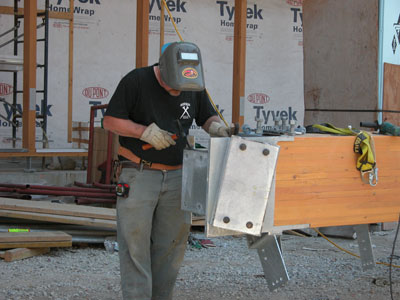 |
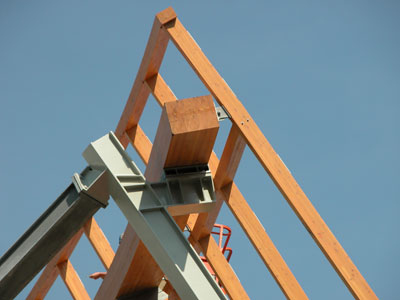 |
The base connectors for these hybrid steel and glulam timber members for the Art Gallery of Ontario by Frank O. Gehry have been fabricated from galvanized steel. The position of the connector in the building put it at greater risk of moisture exposure, so painted steel was not desired. |
Here galvanized steel members are mixed with zinc painted grey steel. It was decided not to galvanize some of the members due to the chance of deformation in the hot zinc bath and potential stress release of the welds. Given the distance from view, the colours are a decent match. |
Metallization
Metalizing is a substitute for painting structural steel that protects steel for significantly longer than paint alone. It is more expensive than galvanizing. Steel of every shape and size may be metalized either in-shop before construction or on-site instead as an alternative to painting. Metalizing is a very versatile and effective coating for protecting steel structures that are to be continuously exposed to weathering.
The metalizing process begins with proper surface preparation. Next, aluminum wire or zinc wire is continuously melted in an electric arc spray or gas flame spray gun. Clean, compressed air strips droplets of molten metal from the wire depositing these particles onto the steel forming the protective coating. This sprayed metal coating is both a barrier coating and a galvanic coating in one. A single metalized coating can protect steel for 30 years or longer depending upon the application, coating thickness and sealing.
Metallizing is thought of as a cold process in that the aluminum or zinc is deposited onto steel by spraying rather than by dipping the steel into a bath of molten zinc as with galvanizing. The steel remains relatively cool at about 120º-150ºC. This means that there is virtually no risk of heat distortion or weld damage by metalizing.
There are no VOC's (volatile organic compounds) in the metalized coating. There is no cure time or temperature to limit metalizing, so metalizing may be applied throughout the year, virtually regardless of temperature.
There are three types of wire that are used to create three specific coatings. Sprayed aluminum is preferred for use in industrial environments, particularly where there are high concentrations of sulfur dioxide and other pollutants. Zinc provides greater galvanic protection than aluminum. Its greater galvanic power protects gaps in the coating better than pure aluminum. It is marginally easier to spray pure zinc than pure aluminum by some flame or arc spray systems. Zinc with 15% aluminum wire combines the benefits of pure zinc with the benefits of pure aluminum in the metalized coating. It is very often used as a substitute for pure zinc because it is somewhat more chloride and sulfur dioxide resistant than pure zinc, while retaining the greater electro-chemical activity of pure zinc.
